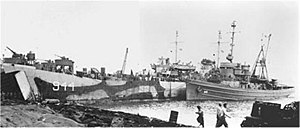USS Zuni (ATF-95)

USS Zuni (ATF-95) on Yellow Beach, Iwo Jima, 23 March 1945, assisting USS LST-944 in beaching,
later became USCGC Tamaroa (WMEC-166) |
|
| History | |
|---|---|
|
|
|
| Name: | USS Zuni |
| Builder: | Commercial Iron Works, Portland, Oregon |
| Laid down: | 8 March 1943 |
| Launched: | 31 July 1943 |
| Commissioned: | 9 October 1943 |
| Decommissioned: | 29 June 1946 |
| Struck: | 19 July 1946 |
| Identification: | ATF-95 |
| Nickname(s): | “The Mighty Z” |
| Fate: |
|
|
|
|
| Name: |
|
| Commissioned: | 29 June 1946 |
| Decommissioned: | 1 February 1994 |
| General characteristics | |
| Class and type: | Navajo-class fleet tug |
| Displacement: | 1,731 long tons (1,759 t) |
| Length: | 205 ft 6 in (62.64 m) |
| Beam: | 39 ft 3.25 in (11.9698 m) |
| Draft: | 18 ft (5.5 m) |
| Propulsion: | 4 × General Motors model 12-278 diesels with diesel-electric drive: 3,010 shp (2,240 kW) |
| Speed: |
|
| Range: | 15,000 nmi (28,000 km; 17,000 mi) at 8 kn (15 km/h; 9.2 mph) (1990) |
| Complement: | 10 officers, 74 enlisted (1990) |
| Sensors and processing systems: |
Radar: SPN-25 (1961); no sonar. |
| Armament: |
|
USS Zuni (AT/ATF-95), a Cherokee-class fleet tugboat, formerly called Navajo class, was a ship of the United States Navy named for the Zuni, the popular name given to a tribe of Pueblo Indians indigenous to the area around the Zuni River in central New Mexico near the Arizona state line.
Zuni (AT-95) was laid down on 8 March 1943 at Portland, Oregon, by the Commercial Iron Works; launched on 31 July 1943; sponsored by Mrs. J. J. O'Donnell; and commissioned on 9 October 1943, Lieutenant Ray E. Chance in command.
Zuni completed shakedown training late in October and on the 28th reported for duty with the Western Sea Frontier, The following day, she departed Puget Sound, bound for Kodiak, Alaska. On 10 November, she stood out of the harbor at Kodiak with two barges in tow. In extremely heavy weather during the voyage south, the towlines to both barges parted; and Zuni experienced great difficulty in keeping herself afloat. Though she managed to maintain contact with the second barge after it broke loose, she ultimately received orders to abandon it and make for Seattle, Washington.
On 1 December, the tug was reassigned to Service Squadron 2 (ServRon 2) and departed Seattle that same day with a barge in tow, bound for Oakland, California. After repairs at Oakland, the tug headed west for the New Hebrides on 27 December 1943, in company with four cargo ships, and arrived in Espiritu Santo at the end of January 1944.
...
Wikipedia
